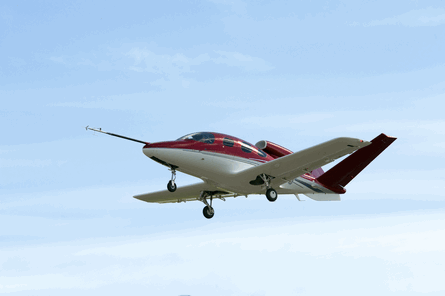Having amassed 25 flight test hours since its first flight on 3 July, the Cirrus Vision SJ50 V1 personal jet test vehicle is being prepared for a rigorous test campaign to validate the technology needed to develop the general aviation aircraft manufacturer's first jet.
Cirrus has so far flown the aircraft to 16,000ft (4,880m) up to speeds of 208kt (385km/h) and as slow as 78kt with partial flaps in straight and level flight, says Mike Van Staagen, vice-president for Cirrus Design's Advanced Development Group.
 |
|---|
© Cirrus |
The early flight tests have been used to eliminate bugs from the electronics, verify data acquisition systems and provide basic flying familiarisation for test pilots.
Early flights were made to prove that the V1 technology demonstrator could fly safely to the AirVenture show in Oshkosh, Wisconsin in July. Having accomplished these goals, Cirrus will use the SJ50 to explore the flight envelope. V1 is a non-conforming aircraft and does not represent a production article.
Pre-familiarisation meetings have been held with the US Federal Aviation Administration ahead of the formal certification campaign, which is set to start late in the third quarter. Certification and first delivery is expected by 2011.
Duluth, Minnesota-based Cirrus is working with its jet advisory team and the Cirrus Owners and Pilots Association to refine its design. As a result, a port side door will replace the original twin-door design. A starboard window plug will enable emergency egress and reduce weight and maintenance costs. In addition, the final design will not include winglets, after no aerodynamic benefit was found.
Cirrus hopes to provide firm pricing and delivery dates to customers within the next year and expects 200-300 more $100,000 refundable deposits before the year is out, on top of the 500 already received. Van Staagen adds that "backlog [before launch] is not the goal, we already know the market is there".
Cirrus plans to begin assembly of the first certification test aircraft in the middle of 2009, leading to first flight in early 2010. The company will select suppliers over the next 12 months and will build on its composite production experience with its SR20 and SR22 with a view to producing around 250 aircraft a year.
Van Staagen says the biggest challenge for the aircraft is weight control. Cirrus has implemented an aggressive programme for the SJ50 to achieve "G3 maturity" at entry into service. G3 refers to the generational iterations of its SR22s that improved performance by reducing weight.
Cirrus's design philosophy is centred on reducing aircraft capabilities to maintain simplicity and performance and to keep the price tag as close to $1 million as possible. Final performance targets are not yet frozen, although Cirrus is talking of a 1,850km (1,000nm) range at medium load with a cruising altitude of 25,000ft and speed of 300kt.
Source: Flight International



















